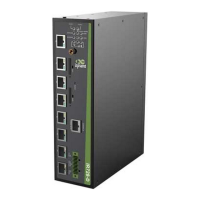5.7 Alarm
Alarm function is a way which is provided for users to get exceptions of device, which can make
the users find and solve exceptions as soon as possible. When abnormality happened, device will
send alarm. User can choose many kinds of exceptions which system defined and choose
appropriate notice way to get these exceptions. All the exceptions should be recorded in alarm log
so that user troubleshoot problem.
According to the type of alarm, it can be divided system alarm and port alarm.
System Alarm: It produces because of system or environment happened to some exception,
divided into temperature, hot start, cold start, power failure, power recovery, insufficient
memory.
Port Alarm: It produces because of the network interface is up or down, divided into LINK-UP,
LINK-DOWN.
Alarm status divided into raise, confirm, clear, When alarm occurs , it is in the state of "raise", if the
user thinks this alarm is not great importance or the exception has been solved , he can directly set it
to "clear" state; if the user is temporarily unable to resolve this anomaly, he can set it to "confirm"
state, when the exceptions had been eliminated , it was set to "clear".
Alarm level can be divided:
EMERG:Device occurs some faults, it could lead to the system restart.
CRIT:Device occurs some faults which are unrecoverable.
WARN:Device occurs some faults which could affect system function.
NOTICE:Device occurs some faults which could affect system properties.
INFO:Device occurs some normal events.
On the “Alarm Status” page, you can view all the alarms since system was power on.
On the “Alarm Input” page, you can define alarm types which you concern.
On the “Alarm Output” page, you can set the way of alarm notice, including relay and Email, log
record is a default output way.
On the “Alarm Map” page, you can map the alarm type which you concern to one or more alarm
notice way.

